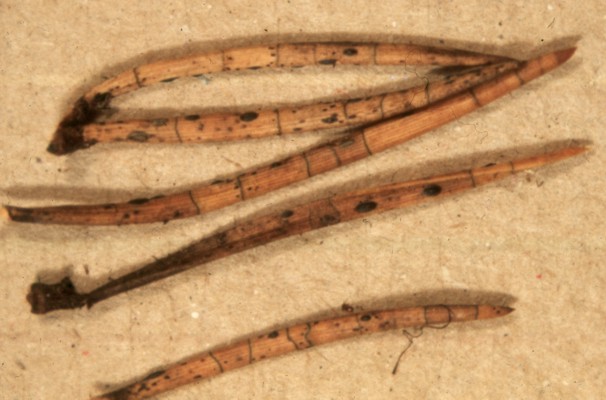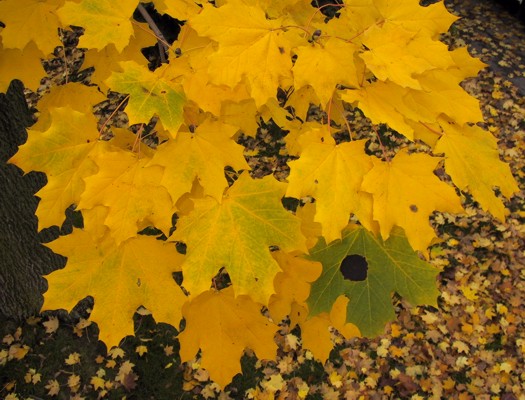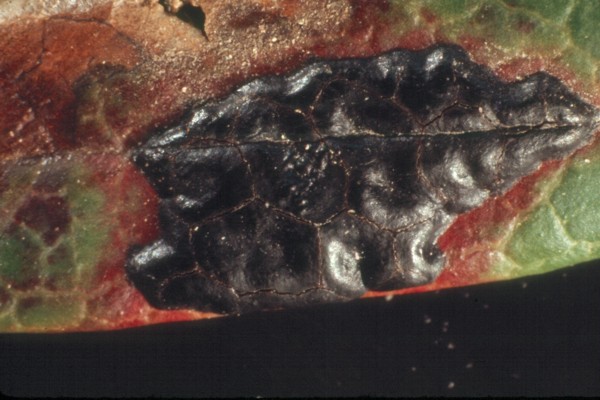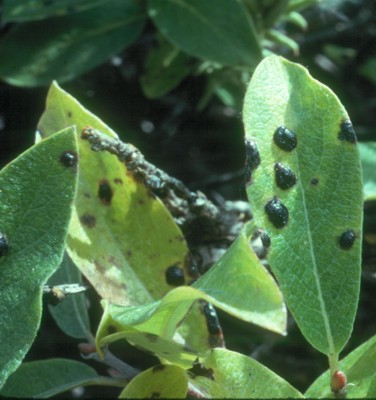Home >> Diversity and classification >> True fungi >> Dikarya >> Ascomycota >> Discomycetes >> Inoperculate Discomycetes >> Rhytismatales
RHYTISMATALES: NEEDLE CASTS AND TAR SPOTS
Members of the Rhytismatales do not look much like cup fungi. Most grow on plants and appear to form closed fruiting structures more like those found among the pyrenomycetes. However, at maturity these structures open either irregularly or along pre-formed lines to reveal a broad layer of inoperculate asci. Because of this mycologists have traditionally aligned them with the inoperculate discomycetes, and now recent genetic evidence suggests that this is where they belong.

The image at left shows some fallen needles of jack pine colonized by Lophodermium pinastre, a common species that can be found on several different species of pine. The apothecia are elliptical and buried below the epidermis of the needles. When moistened by rain these apothecia will split open along a line running down the middle exposing the asci. The black lines separating the apothecia are stromatic barriers that prevent other fungi from entering the territory of the fungus that produced them. These "barrage zones" are common among fungi in many habitats. Lophodermium species are common on plants in our region where they probably grow as harmless or even beneficial endophytes. In some situations they may cause pine needles to fall prematurely, the basis for the term "needle cast disease". Beside the species on pine you may also find L. typhinum on dead cattail stems and L. tumidum on fallen petioles of mountain ash, both common in our region.

The photo at right presents a nice autumn scene with brightly coloured leaves of Norway maple. However, one of those leaves is still green and has a large black spot on it. This "tar spot" is caused by the fungus Rhytisma acerinum. Members of the genus Rhytisma produce large compound apothecia containing several independent layers of asci. When they open, they crack along several lines, not just one.
 Consider the photo at left of Rhytisma andromedae, a species occurring on leaves of Andromeda polifolia, the Bog Rosemary. The tar spot is clearly marked by a mosaic of lines outlining the individual units of the apothecium. At maturity it would have opened along these lines to reveal the layers of asci beneath them.
Consider the photo at left of Rhytisma andromedae, a species occurring on leaves of Andromeda polifolia, the Bog Rosemary. The tar spot is clearly marked by a mosaic of lines outlining the individual units of the apothecium. At maturity it would have opened along these lines to reveal the layers of asci beneath them.

Rhytisma tar spots are produced on the living leaves in late summer and early autumn. The leaves then fall and remain on the ground all winter long. In the spring, at the time the host plant is producing new leaves, the apothecia open up and discharge their ascospores. Sometimes it is difficult to locate leaves with tar spots when they are mature in the spring. They may be hidden among many other uninfected leaves or may be highly decayed or eaten. Often the easiest way to see these fungi in a mature state is to collect the leaves in the autumn and keep then inside a mesh bag on the ground. In the spring the bag can be opened and the leaves removed.
Tar spots can be found on several species of plants, including maple, bog rosemary, mountain holly and willow. The picture at left shows one on willow leaves near the Columbia Icefield on the Alberta-British Columbia border.